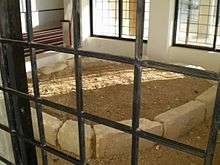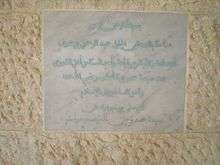'Abd al-Rahman ibn 'Awf
'Abd al-Rahman ibn 'Awf (Arabic: عبد الرحمن بن عوف) (c.581 CE – c.654 CE)[1]:94,103[2] was one of the companions of the Islamic prophet Muhammad. He is known for being one of the Ten Promised Paradise.
Abdul-Rahman ibn 'Awf | |
|---|---|
 The name of Abd al-Rahman ibn Awf's name in Islamic calligraphy | |
| Companion of Muhammad | |
| Born | c. 581 CE Mecca |
| Hometown | Mecca |
| Residence | Medina |
| Died | c. 654 CE (aged 73) Jordan |
| Venerated in | Islam |
| Influences | Muhammad |


Background
His parents were both from the Zuhra clan of the Quraysh tribe in Mecca. His father was 'Awf ibn 'Abd-'Awf and his mother was al-Shifaa bint 'Awf.[1]:94
His original name was Abdu Amr ("servant of Amr"). It was Muhammad who renamed him 'Abd al-Rahman ("servant of the Most Merciful").[1]:94 It is also said that his original name was Abdul Kaaba.[1]:94–95 His name has also been transliterated as Abdel Rahman Ibn Auf.
Conversion to Islam
Abu Bakr spoke to 'Abd al-Rahman about Islam, then invited him to meet Muhammad, who heard his declaration of faith and taught him the Islamic prayers. This was before the Muslims had entered the house of Al-Arqam; 'Abd al-Rahman was one of the first eight men to accept Islam.[3]:115–116[4]
From about 614 the pagan Quraysh in Mecca "showed their enmity to all those who followed the apostle; every clan which contained Muslims was attacked."[3]:143 The usual threat to Muslim merchants was: "We will boycott your goods and reduce you to beggary."[3]:145
'Abd al-Rahman was one of a pioneering party of fifteen Muslims who emigrated to Abyssinia in 615. Other Muslims joined them later, forming a group of over a hundred. "They were safely ensconced there and grateful for the protection of the Negus; so they could worship Allah without fear, and the Negus had shown them kind gesture and warm hospitality as was foretold by the prophet even before they departed."[3]:148 In late 619 or early 620 "they heard that the Meccans had accepted Islam." This turned out not to be entirely true, however a fair number of people did accept Islam as a result of the Conversion of Both Umar ibn Khattab and the prophet's own paternal uncle, the Lion himself, Hamza ibn Abdulmuttalib. 'Abd al-Rahman was one of forty who "set out for the homeland. But when they got near Mecca they learned that the report was false, so that they entered the town under the protection of a citizen or by stealth."[3]:167–168

Emigration to Medina
In 615 he migrated to Abyssinia and In 622 'Abd al-Rahman joined the general emigration of Muslims to Medina, where he lodged with Saad ibn Al-Rabi[3]:218 until he could re-establish his business.
Military campaigns during Muhammad's era
Battle of Badr
'Abd al-Rahman was friends with Umayyah ibn Khalaf, a stern opponent of Islam. When 'Abd al-Rahman emigrated to Medina, the two reached a written agreement, according to which 'Abd al-Rahman was to protect Umayyah's property and family in Medina, while Umayyah would protect 'Abd al-Rahman's in Mecca. When 'Abd al-Rahman wanted to sign the document, Umayyah protested, saying "I do not know Ar-Rahman" and requested that the pre-Islamic name "Abdu Amr" should be used, to which 'Abd al-Rahman agreed.[5]
The two met again in the Battle of Badr in March 624.
A hadith attributed to Abd-al-Rahman ibn Awf reports:
Sunnis tend to view this as Sahih and have included it in Sahih Bukhari [6].
Battle of Uhud
Abd al-Rahman was one of those who stood firmly beside Muhammad at the Battle of Uhud when most of the warriors fled.[1]:98
Invasion of Dumatul-Jandal
In August 626 Muhammad directed 'Abd al-Rahman ibn Awf to raid the Kalb tribe in Daumatul-Jandal, instructing him: “Take it, Ibn Awf; fight everyone in the way of Allah and kill those who disbelieve in Allah. Do not be deceitful with the spoil; do not be treacherous, nor mutilate, nor kill children. This is Allah’s ordinance and the practice of His prophet among you.” Muhammad also instructed him on the correct way to wind a turban.[3]:672 'Abd al-Rahman defeated the Kalbites and extracted from them their declaration of Islam and the payment of the jizya. He then sealed the alliance by marrying the chief's daughter Tamadur bint Al-Asbagh and bringing her back to Medina.[7]:207–208
Role in successions to the Caliphate
In August 634 the dying Caliph Abu Bakr called in 'Abd al-Rahman and Uthman to inform them that he had designated Umar ibn al-Khattab as successor.
In 644 the dying caliph Umar nominated a board of six members (the Council of Shura) to elect one of themselves as the next caliph. The group consisted of Sad Ibn Abi Waqqas, Abd al-Rahman ibn Awf, Zubayr ibn al-Awwam, Talha ibn Ubayd Allah, Ali ibn Abi Talib and Uthman ibn Affan. Uthman was chosen as the third caliph by 'Abd al-Rahman ibn 'Awf.[8]
Personal life
Family
His sister was married to Bilal Ibn Rabah.
He married at least sixteen times and had over thirty known children.[1]:97[9]:77–78
- Umm Habiba bint Zama'a, a sister of Sawda. No children are known from this marriage.
- Umm Kulthum bint Utba of the Abdshams clan of the Quraysh in Mecca.[7]:167
- Salim the Elder (died before Islam).
- The Daughter of Shayba ibn Rabia ibn Abdshams.
- Umm Al-Qasim (born before Islam).
- Habiba bint Jahsh of the Asad tribe, a sister of Zaynab bint Jahsh (childless).[7]:171
- Tamadir bint al-Asbagh of the Kalb tribe. Although Abd al-Rahman divorced her during his final illness, she, like his other three widows, inherited one-thirty-second of his fortune, which was 80,000 or 100,000 dirhams.[1]:104[7]:207–209
- Abdullah the Younger (Abu Salama).
- Umm Kulthum bint Uqba from the Umayya clan of the Quraysh in Mecca.[7]:163
- Muhammad, from whom he took his kunya of Abu Muhammad.
- Ibrahim.
- Humayd.
- Isma'il.
- Hamida.
- Amat ar-Rahman the Elder.
- Sahla bint Asim from the Baliyy tribe of Medina.
- Maan.
- Umar.
- Zayd.
- Amat ar-Rahman the Younger.
- Bahriya bint Hani of the Shayban tribe.
- Urwa the Elder (killed at Ifriqiya).
- Sahla bint Suhayl of the Amir ibn Luayy clan of the Quraysh.[7]:190
- Salim the Younger (killed at Ifriqiya).
- Umm Hakim bint Qariz of the Kinana tribe.[7]:304–305[9]
- Abu Bakr.
- The Daughter of Abu al-His ibn Rafi from the Abdulashhal ibn Aws tribe of Medina.
- Abdullah (killed during the conquest of Africa)
- Asma bint Salama
- 'Abd al-Rahman.
- Umm Horayth, a war-captive from Bahra
- Mus'ab.
- Amina.
- Maryam.
- Majd bint Yazid from the Himyar tribe.
- Suhyal (Abu'l-Abayd)
- Zaynab bint As-Sabbah.
- Umm Yahya.
- Badiya bint Ghaylan from the Thaqif tribe.
- Juwayriya.
- Ghazzal bint Khosrau (concubine), a war-captive from Al-Mada'in
- Uthman
- Other Concubines (unnamed).
'Abd al-Rahman was known as a business sensation in world.[10][11] When he was asked about the secret of his success, he replied that he never lifted a stone unless he expected to find gold or silver under it.[1]:96
Generosity
Many stories are told of 'Abd al-Rahman's personal generosity. He once furnished Muhammad's army with 1,500 camels. He bequeathed 400 dinars to the survivors of Badr and a large legacy to the widows of Muhammad. One day he brought a caravan of 700 merchant-camels into Medina. Aisha remarked, "I have heard the Allah's Messenger say: 'I have seen 'Abd al-Rahman ibn Awf entering Paradise crawling.'" This was repeated to 'Abd al-Rahman, who replied: "If I could, I would certainly like to enter Paradise standing. I swear to you, yaa Ammah, that this entire caravan with all its merchandise, I will give in charity." And so he did.[12]
Physical Features
'Abd al-Rahman ibn 'Awf was tall and bent-backed with a fine, light, rosy complexion and a handsome face. In old age he did not dye his hair.[1]:101 Other descriptions refer to his curly hair; lustrous, long-lashed eyes; convex nose; somewhat protruding upper teeth; thick hair under the earlobes; long, elegant neck; and thick, masculine hands and fingers. He had a limp due to the wounds that he incurred at the Battle of Uhud.
Death
'Abd al-Rahman died in the Levant (بلاد الشام) in 33 AH (653-654 CE) at the age of 75 (lunar) years.[1]:103 He was buried on a hill to the north-east of present-day Amman, Jordan.[13]
Sunni view
Sunnis regard him as one of the al-asharatu-l mubashshirin, the ten people whom Muhammad personally assured of entering Paradise.
See also
- Sahaba
- The Ten Promised Paradise
- Sunni view of the Sahaba
- List of expeditions of Muhammad
- Banu Kalb
References
- Muhammad ibn Saad. Kitab al-Tabaqat al-Kabir Volume 3. Translated by Bewley, A. (2013). The Companions of Badr. London: Ta-Ha Publishers.
- "Abdul-Rahman Ibn Awf (580Ad-32Hijri/652Ad) A study in his Religions, Economic and Political Role in the State of Islam During its Emergence and Formation". An-Najah Scholars. An-Najah National University. 2014. Archived from the original on 25 June 2016. Retrieved 22 May 2016.
- Muhammad ibn Ishaq. Sirat Rasul Allah. Translated by Guillaume, A. (1955). The Life of Muhammad. Oxford: Oxford University Press.
- Note that the expression "the first eight men" does not include a few female converts whose profession of faith may have been earlier.
- Sahih al-Bukhari, 3:38:498
- USC-MSA Compendium of Muslim Texts Archived 2005-12-02 at the Wayback Machine
- Muhammad ibn Saad. Kitab al-Tabaqat al-Kabir Volume 8. Translated by Bewley, A. (1995). The Women of Madina. London: Ta-Ha Publishers.
- "Family and Women Affairs". Archived from the original on 2014-01-09. Retrieved 2013-09-08.
- Ahmed, A. 1. (2011). The Religious Elite of the Early Islamic Hijaz: Five Prosopographical Case Studies. Oxford: Unity for Prosopographical Research.
- "Lessons for Muslim Men in the life of Abdul Rahman ibn Awf". The Ideal Muslim Man. 2015-12-02. Archived from the original on 2017-04-11. Retrieved 2017-04-10.
- "Wealthy Sahaba : Abdur Rahman bin Auf". Archived from the original on 2017-04-10. Retrieved 2017-04-10.
- Abdur-Rahman Ibn Awf, The Richest Muslim Who Bought His Way to Jannah Archived 2015-12-11 at the Wayback Machine
- Malhas Tours Archived 2014-12-19 at the Wayback Machine